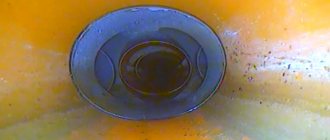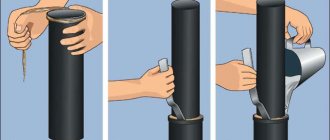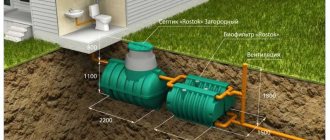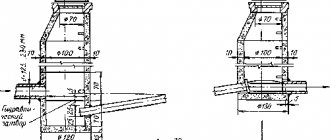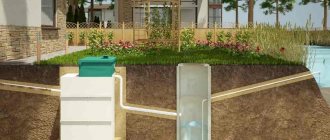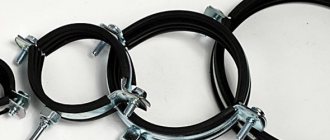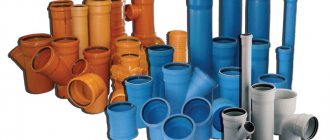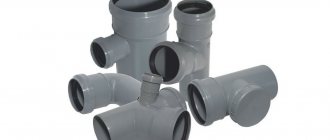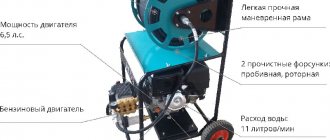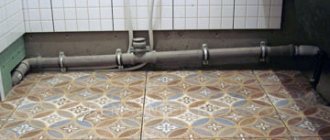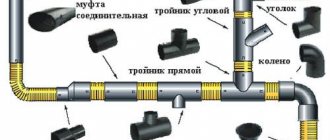Did you know that a video camera inspection of a sewer system is called a sewer television inspection? So what is it, what types of devices are there, and when does the need for this method arise.
It often happens that blockages constantly occur in the same section of the sewer system. Determining the reason for this persistence is extremely difficult. Usually there is no assumption that may become an obstacle to the free passage of wastewater. It is not always possible to dig a trench and carry out an inspection. The problem area may be under highways, structures or other objects. Visual inspection of pipelines using special equipment, or tele-inspection of sewerage, allows you to get an answer to all questions. Let's take a closer look at this method.
What is teleinspection of pipelines
Teleinspection is a relatively new technique for diagnosing sewerage systems. A video camera with illumination mounted on a trolley is placed in the internal cavity of the pipe.
The complex is capable of independently moving within the system and transmitting an image to a screen located on the daylight surface. Video diagnostics of sewer pipes allows you to get comprehensive answers to all questions about the causes of blockages or the condition of the system. The ability to see the surface of pipes from the inside significantly speeds up repair work. Telemetry provides full control of the system condition before and after repair and demonstrates its effectiveness. Compared to traditional methods of working “blindly”, this option significantly reduces the possibility of erroneous decisions.
Leak diagnostics and trenchless repairs
Finding pipeline leaks is a time-consuming procedure, but with tele-inspection equipment it is quite easy to identify the problem by conducting regular inspections. It is important to remember that water mains are not always suitable for such an inspection due to the presence of pressure, but if the search is complicated by the density of networks and mains (as in large cities), then the method is considered the most effective.
If the fistula is located in a place that is difficult to excavate, then using equipment equipped with an additional packer, it is possible not only to detect the hole, but also to eliminate the hole.
Kärcher hoses for pressure drain cleaning
Inspection of the sewer pipe system and subsequent use of trenchless repair equipment is the most common procedure where equipment is present. Before the process begins, all areas are inspected using television cameras to identify obstacles, and then options for elimination are worked out. In particular, trenchless repair involves local renovation of areas using repair robots.
Method capabilities
Inspecting the sewer system with a video camera allows you to examine the surface of the pipes from the inside and detect flaws, cracks, foreign objects, etc. Possibilities of this technique:
- quick and accurate determination of the location of the blockage;
- identifying the cause of the traffic jam;
- the ability to visually assess the nature and type of surface defects;
- performing restoration or repair without excavation work.
The value of the technique lies in greatly speeding up the process of removing a blockage or determining the location of a leak. Checking the sewer system with a camera does not require serious preparation and can be performed at any convenient time. Often, a video diagnostic procedure is performed to determine the results of flushing the system after inserting a branch or other work. Errors must be immediately identified and corrected. For example, when cutting in, an obstacle often arises in the form of a piece of pipe that blocks the passage for drains. Blockages will definitely occur in this place. After using the video camera, you can immediately redo the job while the trench is open. Then you will have to dig everything up again, which is time-consuming and expensive.
Monitoring the condition of new highways
This is another area where the use of teleinspection is a must. Monitoring and inspection of the condition of the sewer pipeline system, water pipelines being put into operation and acceptance of pipelines from the builders with the signing of the conclusion and transfer certificate is a guarantee of the correctness of the work performed and an uninterrupted drainage and water supply system.
Rules for installing sewerage systems
The effectiveness of the measure has been confirmed by practice, and in each specific case, the work is carried out at the expense of the controlling and receiving organization. If deficiencies are identified, their elimination falls on the contractor. Key acceptance indicators:
- no accumulation of debris;
- absence of foreign objects in the pipe line (according to SNiP);
- quality of butt joints (socket, welded);
- assessment of the condition of the internal surfaces of pipes for the presence of mechanical damage, strength indicators and resistance to the pumped media.
Types of devices for teleinspection
Sewer inspections are carried out using devices of varying complexity. The main element in any case is the television camera. Only the supporting systems differ:
- handheld camera . This is a long handle with a camera installed at one end. It can be rotated to target areas of interest. At the other end is a screen displaying video footage;
- push camera. Used to survey more remote areas of the system. Designed for testing relatively thin pipes (diameter from 25 mm). It consists of a camera on a flexible cable, a monitor and a control panel. The design allows you to push the probe over a distance of up to 100 m;
- robotic systems. These are the most effective structures, capable of moving independently inside a pipe with a diameter of 150 mm. They are autonomous and can be removed from receiving devices over considerable distances.
Sewer diagnostics with a video camera is the most informative way to inspect the sewer network. Robotic designs are considered the most effective, but they are the most expensive. All types of diagnostic systems provide high-quality results; the only difference is in the distance the camera moves inside the pipeline.
Video diagnostics of sewerage and drainage systems
| Video diagnostics allows you to accurately and quickly check the condition and serviceability of sewerage and drainage. |
Video diagnostics allows you to accurately and quickly check the condition and serviceability of sewerage and drainage. Diagnostics of sewer collectors, wells and water supply systems is needed to accurately identify the location of damage or blockage. This is necessary to carry out timely local or major repairs and prevent failure.
With the help of television inspection, it is possible to determine the location of paved and lost wells. The method helps to thoroughly examine the technical condition and detect defects in sewer lines, so it is often used as a preventive control measure.
Teleinspection has important practical significance. Clearing blockages in sewer collectors in a timely manner prevents sewage from spilling into the street. Timely detection of a damaged sewer section allows it to be repaired, preventing overload of treatment facilities caused by storm water entering the sewer network.
When does the procedure need to be performed?
Telemetry of sewerage pipelines is carried out to examine the internal cavity of the sewerage system. The need for the procedure arises in different situations:
- blockages that often occur in the same area;
- search for leaks;
- inspection of pipe joints;
- checking the quality of tapping into the main pipeline;
- performing repairs;
- restoration of connections;
- commissioning of a new main line.
Teleinspection of sewer pipes makes it possible to examine and identify problem areas. It is also used to carry out repair work. Often, a type of coupling is installed on the defective section of the pipeline from the inside, reinforcing and sealing the internal walls of the pipe. The device that installs this device is called a packer. A rupture or crack in the pipeline is reliably closed with a solid cylinder made of durable elastic material.
It is impossible to do this kind of work blindly. Video diagnostics of sewerage allows you to avoid excavation work and significantly saves time.
You may also like:
Sewer cleaning machine: principle of operation, types, features
Cleaning the sewer and removing blockages - rules and methods
Sewer teleinspection: price of services
Television sewer inspection price from 80 rub. per linear meter. The exact cost of teleinspection of pipelines and sewer pipes is discussed with the manager immediately, or we go out for an assessment and an accurate calculation. The initially announced price remains unchanged, and a guarantee for the services is provided.
The Kanalservice company offers teleinspection services for sewerage pipelines in Moscow and the Moscow region at a competitive cost. Based on the results of the work performed, you receive a detailed report, which reflects information such as:
- Detailed diagram of the examined fragment.
- The results of the inspection of each section indicating the identified problems (condition of pipes and fittings, presence of deposits and their nature, etc.). The inspected fragment is divided into parts of a certain length for a high-quality detailed examination.
- Photo and video materials based on the results of television inspection of pipes with explanations.
- Comments and recommendations based on the survey results.
Kanalservice carries out television inspection of industrial, domestic and storm sewers. You can also order from us an inspection of other types of communications (water supply, heat supply systems with different types of coolants, etc.).
Rehabilitation of pipelines
The condition of the sewage system is gradually deteriorating. This is a natural process caused by the deposition of fatty deposits, accumulation of fibrous particles or solid deposits on the pipe walls. The most effective way to remove these layers is hydrodynamic cleaning. It is produced by a jet of water under high pressure. After such cleaning, it is recommended to inspect the sewer with a video camera, which demonstrates the results obtained. If the surface of the pipes is not sufficiently freed from deposits, repeated cleaning is necessary. There is an opportunity to save on calling the washing machine again and immediately repeat the procedure.
In addition, sewer diagnostics using a video camera allows you to find leaks. This makes it possible to avoid excavation work, dismantling pipes and stopping the system during repairs. For industrial or large public systems, such a solution provides significant benefits. Carrying out such a check does not take much time.
Another way to apply the technique is to monitor pipe connections. Operation in underground conditions creates a lot of stress. They significantly reduce the service life of the system. The most vulnerable areas are connections that can be destroyed by temperature or mechanical influences. The survey provides a complete picture of the condition of all sections of the highway. When performing the procedure, you can immediately draw up a defect sheet, which indicates all the problem areas and describes the nature and type of damage. According to the report, materials for repairs are prepared and a method for solving problems is chosen. Possible options:
- application of protective coatings;
- installation of elastic sleeves;
- introduction of couplings;
- installation of sheet patches;
- the use of modern spiral polymers that form hermetic coatings.
All methods of sanitation are impossible without a preliminary inspection of the pipeline cavity. Teleinspection of the system gives high results and does not require costs. Alternative methods of problem solving cannot show such results.
Hydrodynamic cleaning: use of devices for collectors and storage tanks
If certain sections of the pipeline system are often clogged and require cleaning, it is necessary to find out the cause of the malfunction.
But it happens that such pipe sections are not subject to internal visual inspection due to the presence of slopes, counterslopes and other obstacles. A tele-inspection will help identify the problem of drainage obstruction and eliminate blockages that appear due to, for example, soil displacement, poor-quality laying and other reasons. Using the equipment, you can not only identify deficiencies, but also choose the simplest and most effective method for eliminating them, without the need to destroy a section of pipelines, construct a manhole, or use expensive equipment. All destruction is visible on the television screen, counter-slopes are shown by an inclinometer, which is necessarily equipped with any model of equipment.
Inspection of internal sewerage
Indoor sewer systems have many causes for clogs, interruptions, or improper service. Incorrect angle of inclination of branches, untimely inspection of common risers, poor-quality work on systematic cleaning of communications, violation of design calculations, steep rotation angles and other defects lead to failure of sewer systems. Disputes often arise between residents and management companies about the management of nearby communications and the responsibilities of repairs and maintenance. According to urban planning standards and other technical regulations, management companies are responsible for general sewerage systems - vertical risers and intra-house general wiring. All communications of intra-apartment sewerage systems belong to the owners of the apartments and the owner of the living space bears responsibility for disruption of the operation of communications. If violation of the operation of the intra-apartment sewerage system leads to emergency situations in adjacent apartments and other areas, the owner of the apartment bears responsibility.
Sewage systems are the main engineering communications that are subject to the greatest depreciation during the operation of a house. In this connection, a mandatory and complete systematic audit will eliminate the occurrence of emergency situations. Management companies, in accordance with technical regulations and norms of urban planning legislation, are required to conduct a commission inspection every six months, with the mandatory preparation of Inspection Reports and surveys of sewerage systems.
Uninterrupted operation of hot and cold water, compliance with the requirements of SanPiN (sanitary and epidemiological standards) are interconnected with the proper and trouble-free operation of sewer communications; understanding these simple things and rules, as well as timely revision, will eliminate extremely unpleasant procedures for repairing sewer utility systems.
See also:
- Sewerage examination
- Water supply system inspection
